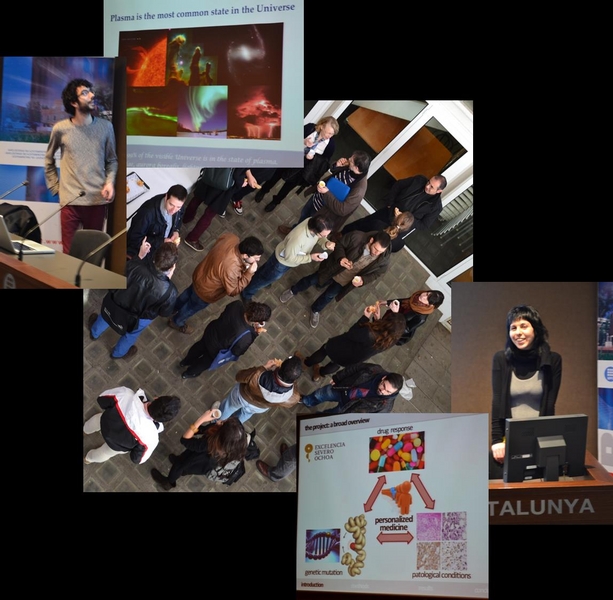 This year's Christmas lectures on the BSC Severo Ochoa Research Seminar are in the area of Computational Science.
This year's Christmas lectures on the BSC Severo Ochoa Research Seminar are in the area of Computational Science.
Equilibrium and stability of fusion plasmas via three-dimensional Magneto-Hydrodynamics
Invited Speaker: Dr. Joaquim Loizu from Princeton Plasma Physics Laboratory
Abstract: Controlled nuclear fusion could provide our society with a clean, safe, and virtually inexhaustible source of electric power production. Magnetic fusion has proven to be capable of producing large amounts of fusion reactions by confining magnetically the fusion fuel at sufficiently high density and temperature, thus in the plasma state. Similarly to neutral fluids, plasmas often exhibit instabilities and turbulent behaviour. This limits the performance of magnetic fusion devices such as tokamaks and stellarators.
The general theory to describe the macroscopic equilibrium and stability of magnetically confined fusion plasmas is the so-called Magneto-Hydrodynamics (MHD) theory. Two-dimensional MHD, typically enough to describe devices with certain continuous symmetries, has been shown to be a very powerful tool to understand which regimes of operation are optimal in terms of performance and stability. However, three-dimensional MHD, still not fully understood, has become necessary to describe future fusion devices which are designed to have no continuous symmetries.
In this talk, I will summarize the concepts of plasma, magnetic fusion, and MHD theory. Then I will describe a recently developed theory, referred to as Relaxed-MHD, which is capable of describing the equilibrium and stability of three-dimensional magnetically confined fusion plasmas. In particular, I will describe a state-of-the-art numerical code that implements this theory and I will show some examples of computed plasma equilibria.
Bio: Joaquim Loizu graduated in Physics at the Ecole Polytechnique Fédérale de Lausanne, carrying out his master thesis project at the Center for Bio-Inspired Technology, Imperial College London, on the theoretical and numerical study of the biophysics of light-sensitive neurons.
In 2009, he started his PhD studies with Prof. Paolo Ricci at the Centre de Recherches en Physique des Plasmas, the major plasma and fusion laboratory in Switzerland. His thesis focused on the theory of plasma-wall interactions and their effect on the mean flows and turbulence in magnetized plasmas. During his PhD, he developed first-principle analytical theories and performed both kinetic and fluid numerical simulations.
In 2014, he joined the Max-Planck-Princeton Center for plasma research as a Postdoctoral Research Fellow. His main research line is currently focused on the macroscopic equilibrium and stability of magnetically confined fusion plasmas. He is currently at the Princeton Plasma Physics Laboratory working with Dr. Stuart Hudson and Prof. Amitava Bhattacharjee on three-dimensional magnetohydrodynamics.
coffee break
Enhanced molecular dynamics to understand the structural and energetics determinants of MEK1 pathological mutations
Speaker: Chiara Pallara, BSC
Abstract: Protein kinases are key regulators of eukaryotic living cells, since they are involved in crucial biochemical functions and signalling networks. These enzymes share a common fold and can switch between distinctive inactive and active states in response to specific cellular signals. One relevant example is the MAPK/ERK cascade, which is involved in important cell processes like gene expression, cell proliferation, differentiation and apoptosis.
Dysregulation of MEK1/2, a key component of MAPK/ERK cascade, is known to cause several important pathologies. At least 15 activating mutations of MEK1/2 are associated with the CFC syndrome, while at least other 10 have been identified in several cancer types (melanoma, lung and ovarian cancer).
Understanding the effects of these mutations at molecular level could help to use MEK1 as potential target to develop personalized therapies for cancer and CFC-syndrome. Unfortunately, although both active and inactive MEK1 structures are already known, the detailed mechanism of MEK1 activation and the functional impact of CFC-syndrome related mutations are not yet clear.
During my talk I will summarize our recent findings on the intrinsic propensity for inactive-to-active transition in MEK1 WT and two CFC syndrome-related mutants (Y130C and Q56P), using state-of-the-art enhanced sampling methods such as Parallel Tempering metadynamics in Well-Tempered Ensemble (PT-metaD-WTE.
Biography: Chiara Pallara received her degree in Pharmaceutical Chemistry, at the University of Bologna in 2009.
In 2010, she joined the Protein Interactions and Docking Group, led by Juan Fernandez-Recio, as phD student. During her thesis she gained experience in theoretical chemistry and structural biology, especially in the fields of protein-protein docking and molecular dynamics methods.
Her main research line is currently focused on the development and optimization of computational protocols to integrate conformational flexibility into docking simulations for the characterization of protein-protein interactions. In addition she contributed to several multidisciplinary research projects involving the application of standard molecular dynamics simulations on different protein systems to understand the mechanistic effects of specific mutations, ligands binding or proteins association.
During the last three months, she performed a short-stay in the Biomolecular Modeling group led by Prof. Gervasio in the Department of Chemistry of UCL where she gained experience in enhanced molecular dynamics methods to sample rare events in bio-molecular systems.
